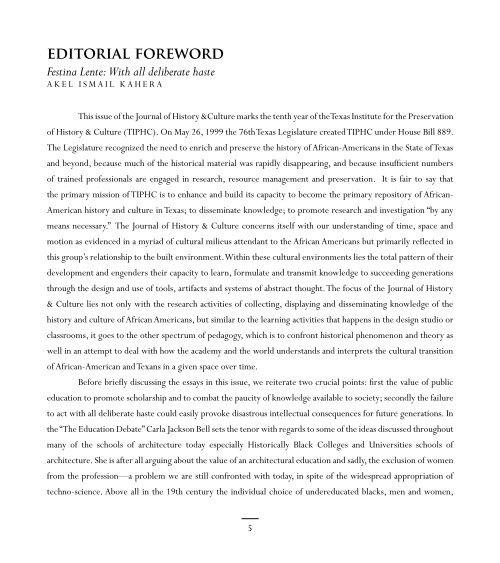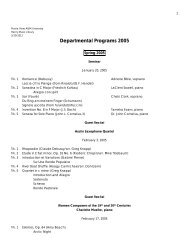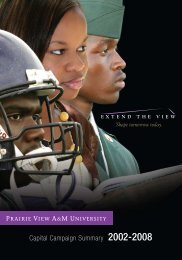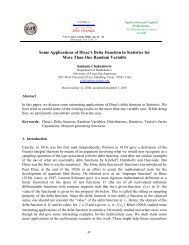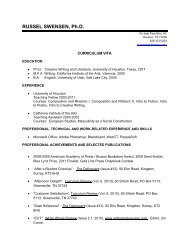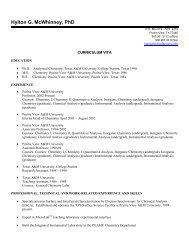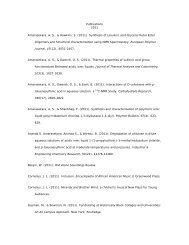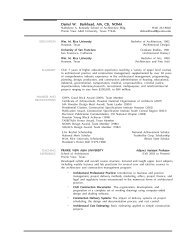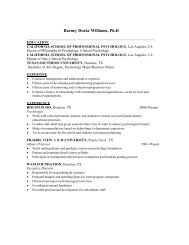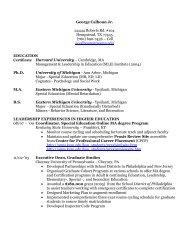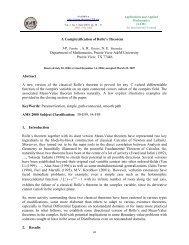Journal of History and Culture Journal of History and Culture
Journal of History and Culture Journal of History and Culture
Journal of History and Culture Journal of History and Culture
You also want an ePaper? Increase the reach of your titles
YUMPU automatically turns print PDFs into web optimized ePapers that Google loves.
editorial foreword<br />
Festina Lente: With all deliberate haste<br />
A KEL ISMAIL KAHERA<br />
This issue <strong>of</strong> the <strong>Journal</strong> <strong>of</strong> <strong>History</strong> &<strong>Culture</strong> marks the tenth year <strong>of</strong> the Texas Institute for the Preservation<br />
<strong>of</strong> <strong>History</strong> & <strong>Culture</strong> (TIPHC). On May 26, 1999 the 76th Texas Legislature created TIPHC under House Bill 889.<br />
The Legislature recognized the need to enrich <strong>and</strong> preserve the history <strong>of</strong> African-Americans in the State <strong>of</strong> Texas<br />
<strong>and</strong> beyond, because much <strong>of</strong> the historical material was rapidly disappearing, <strong>and</strong> because insufficient numbers<br />
<strong>of</strong> trained pr<strong>of</strong>essionals are engaged in research, resource management <strong>and</strong> preservation. It is fair to say that<br />
the primary mission <strong>of</strong> TIPHC is to enhance <strong>and</strong> build its capacity to become the primary repository <strong>of</strong> African-<br />
American history <strong>and</strong> culture in Texas; to disseminate knowledge; to promote research <strong>and</strong> investigation “by any<br />
means necessary.” The <strong>Journal</strong> <strong>of</strong> <strong>History</strong> & <strong>Culture</strong> concerns itself with our underst<strong>and</strong>ing <strong>of</strong> time, space <strong>and</strong><br />
motion as evidenced in a myriad <strong>of</strong> cultural milieus attendant to the African Americans but primarily reflected in<br />
this group’s relationship to the built environment. Within these cultural environments lies the total pattern <strong>of</strong> their<br />
development <strong>and</strong> engenders their capacity to learn, formulate <strong>and</strong> transmit knowledge to succeeding generations<br />
through the design <strong>and</strong> use <strong>of</strong> tools, artifacts <strong>and</strong> systems <strong>of</strong> abstract thought. The focus <strong>of</strong> the <strong>Journal</strong> <strong>of</strong> <strong>History</strong><br />
& <strong>Culture</strong> lies not only with the research activities <strong>of</strong> collecting, displaying <strong>and</strong> disseminating knowledge <strong>of</strong> the<br />
history <strong>and</strong> culture <strong>of</strong> African Americans, but similar to the learning activities that happens in the design studio or<br />
classrooms, it goes to the other spectrum <strong>of</strong> pedagogy, which is to confront historical phenomenon <strong>and</strong> theory as<br />
well in an attempt to deal with how the academy <strong>and</strong> the world underst<strong>and</strong>s <strong>and</strong> interprets the cultural transition<br />
<strong>of</strong> African-American <strong>and</strong> Texans in a given space over time.<br />
Before briefly discussing the essays in this issue, we reiterate two crucial points: first the value <strong>of</strong> public<br />
education to promote scholarship <strong>and</strong> to combat the paucity <strong>of</strong> knowledge available to society; secondly the failure<br />
to act with all deliberate haste could easily provoke disastrous intellectual consequences for future generations. In<br />
the “The Education Debate” Carla Jackson Bell sets the tenor with regards to some <strong>of</strong> the ideas discussed throughout<br />
many <strong>of</strong> the schools <strong>of</strong> architecture today especially Historically Black Colleges <strong>and</strong> Universities schools <strong>of</strong><br />
architecture. She is after all arguing about the value <strong>of</strong> an architectural education <strong>and</strong> sadly, the exclusion <strong>of</strong> women<br />
from the pr<strong>of</strong>ession—a problem we are still confronted with today, in spite <strong>of</strong> the widespread appropriation <strong>of</strong><br />
techno-science. Above all in the 19th century the individual choice <strong>of</strong> undereducated blacks, men <strong>and</strong> women,<br />
5


